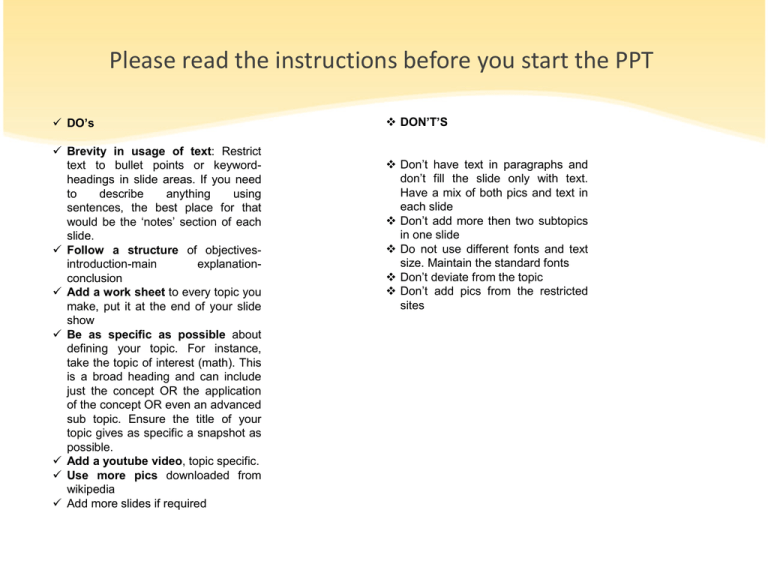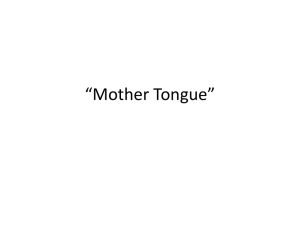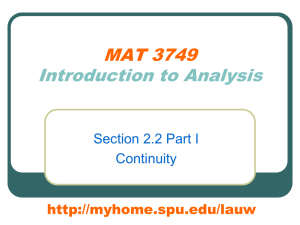Theorem - eGurukul
advertisement

Please read the instructions before you start the PPT
DO’s
Brevity in usage of text: Restrict
text to bullet points or keywordheadings in slide areas. If you need
to
describe
anything
using
sentences, the best place for that
would be the ‘notes’ section of each
slide.
Follow a structure of objectivesintroduction-main
explanationconclusion
Add a work sheet to every topic you
make, put it at the end of your slide
show
Be as specific as possible about
defining your topic. For instance,
take the topic of interest (math). This
is a broad heading and can include
just the concept OR the application
of the concept OR even an advanced
sub topic. Ensure the title of your
topic gives as specific a snapshot as
possible.
Add a youtube video, topic specific.
Use more pics downloaded from
wikipedia
Add more slides if required
DON’T’S
Don’t have text in paragraphs and
don’t fill the slide only with text.
Have a mix of both pics and text in
each slide
Don’t add more then two subtopics
in one slide
Do not use different fonts and text
size. Maintain the standard fonts
Don’t deviate from the topic
Don’t add pics from the restricted
sites
Chapter-11 MID POINT THEOREM
MATH CLASS-9
Module Objectives
•
•
•
•
State the mid-point theorem.
Prove mid-point theorem logically.
State the converse of mid-point theorem.
Solve problems and riders based on the mid-point theorem.
Analysis of Mid-Point Theorem
Construct the triangles as given below. D and E are the mid-points of the sides of AB
and AC of the ∆ABC.
(i)
(ii)
(iii)
Measure the lengths of DE and BC and the magnitudes of ABC and ADE in each
case and complete the table given in the following slide.
Analysis of Mid-Point Theorem
FIG NO.
DE
BC
ADE
ABC
i)
ii)
iii)
With the help of the above table answer the following questions:
1. What is the relation between the lengths of DE and BC?
2. What is the relation between ADE and ABC ?
3. What type of angles are ADE and ABC ?
4. Hence what type of lines are DE and BC ?
From the measurements you will observe that,
DE is half of BC. i.e. DE = 1/ 2 (BC).The corresponding angles ADE and ABC are
equal.
Hence , DE || BC.
Proof of Mid-Point Theorem
•
Theorem : The line joining the mid-points of any two sides of a triangle is parallel to and half
of the third side.
Data : In ∆ABC , D is the midpoint of AB and E is the
midpoint of AC
To Prove: (i) DE ||BC
(ii) DE = ½ BC
Analysis:
On what basis can we prove lines are parallel ?
(1) Corresponding or alternate angles are equal.
(2) The lines form the opposite sides of a
parallelogram.
Proof of Mid-Point Theorem
•
•
•
We not only have to prove DE || BC but also DE = ½ BC .How can we do this ?
This is possible by constructing a parallelogram which has BC and DF as its sides.
How can we show that DBCF is a parallelogram?
This is possible by proving DB = CF and DB ||CF
By constructing CF || DB.
We cannot prove that DB = CF directly.But we know DB = DA.
How can we prove that DB = CF ?
So we will prove DA = CF
Hence prove DB = CF by proving ∆ ADE ≡ ∆ EFC.
How can we prove that ∆ ADE ≡ ∆ EFC ?
By applying A.S.A postulate.
Proof of Mid-Point Theorem
Hence ,in order to prove DE || BC and DE = ½ BC logically, we need to
a) Construct CF || AB
b) Prove ∆ ADE ≡ ∆ EFC.
c) Prove DBCF is a parallelogram.
Theorem : The line segment joining the midpoints of any two sides of a triangle is
parallel to the third side and is equal to half of it.
Data : In ∆ ABC , D is the midpoint of AB and E is the midpoint of AC.
Proof of Mid-Point Theorem
To prove : DE || BC and DE = ½ BC.
Construction : From C, draw a line parallel to BA. Produce DE to meet this line at F.
STATEMENT
In ∆ADE and ∆ EFC, AE = EC
AED
=
DAE =
CEF
ECF
REASON
given
Vertically opposite angles.
Alternate angles. DA || CF
Hence , ∆ ADE ≡ ∆ EFC.
By A.S.A postulate
Hence , AD = CF and DE = EF
Corresponding parts of congruent ∆s.
But AD = BD
given., D is the midpoint of AB
Therefore, CF = BD
From the above two statements
Thus, DBCF is a parallelogram.
Opposite sides of CF and BD are equal
and parallel.
So, DE || BC
Opposite sides of a parallelogram are
parallel.
Proof of Mid-Point Theorem
STATEMENT
REASON
Now DE = EF
∆ADE ≡ ∆ CEF
DE = ½ BC
In parallelogram DBCF, DF = BC
Therefore , DE || BC and DE = ½ BC.
Hence , it is proved that, the line segment joining the mid points of any two
sides of a triangle is parallel to the third side and is equal to half of it.
Note: Prove this theorem by changing the construction as : Produce DE to F
such that EF = DE.
Converse of the theorem :
The straight line drawn through the midpoint of one side of a triangle and
parallel to another , bisects the third side.
Activity: a) Prove the above statement logically.
b) Verify it by practical method.
Examples
Example 1 : In the given figure , AB = 8.4 cm ,PR = 5.0 and PQ = 4.8cm .Find the length
of BC,CA and QR. If APR =45⁰, find ABC.
Given : AB = 8.4cm
PR = 5.0 cm
PQ = 4.8 cm
Solution :
(1) BC = 2 * PR (Theorem 3)
(2) CA = 2 * PQ (Theorem 3)
BC = 2 * 5
CA = 2 * 4.8
BC = 10 cm
CA = 9.6 cm
(3) QR = ½ AB
(Theorem 3)
(4) B = APR = 45⁰
QR = ½ * 8.4
QR = 4.2 cm
Therefore, PR || BC , corresponding angles are equal.
Examples
Example 2 : Prove that the figure obtained by joining the mid-points of the adjacent
Sides of a quadrilateral ABCD.
To Prove: PQRS is a parallelogram.
Construction : Join BD.
Proof:
In ∆ABD, PS || BD and PS = ½ BD {Since, line joining the midpoints of two sides of a
∆ is parallel to and half the third side.}
In ∆BCD, QR || BD and QR = ½ BD
Therefore, PS || QR, PS = QR.
Hence PQRS is a parallelogram.
Do it Yourself
1) In ∆ ABC , D is mid-point of AB and E is mid point of BC. Calculate :
i) DE , if AC = 6.4 cm.
ii) DEB , if ACB = 63⁰
2.In ∆ PQR , A,B,C are the midpoints of sides PQ,QR and RP. If
the perimeter of ∆ PQR = 32 cm ,what is the perimeter of
∆ ABC ?
3) In the figure, X and Y are the midpoints of AB and AC respectively. Given that BC =
6cm.AB = 5.4 cm and AC = 5.0 cm. Calculate :
i) The perimeter of ∆ AXY.
ii) The perimeter of trapezium BCYX.
Do it Yourself
4) In ∆ ABC ,’Q’ and ‘M’ are the midpoints of AB and AC respectively. P and L are the
midpoints of AQ and AM respectively .If BC = 12 cm , find the length of PL.
5) Construct ∆ ABC, given BC = 7cm, AB = 8 cm and AC = 6cm . Mark D and E the
midpoints of AB and AC respectively. Construct parallelograms DBCF and ECBG.
6) Prove that the four triangles obtained by joining the midpoints of the sides of a
triangle are congruent.
7) Prove that the figure obtained by the joining the midpoints of the adjacent sides
of a rhombus is a rectangle.
8) In the given figure, PQRS is a parallelogram .
A and B are the midpoints of sides SP and SR
respectively .Prove that the area of ∆APR is
equal to area of ∆BPR.
Do it Yourself
9) Use the following figure to prove that : ( AB || PR || DC )
i) R is the mid-point of BC.
ii) PR = ½ ( AB + DC )
10) D,E and F are the mid-points of the sides AB,BC and CA of an isosceles ∆ ABC in
which AB = BC. Prove that ∆ DEF is also isosceles.
END OF CHAPTER







